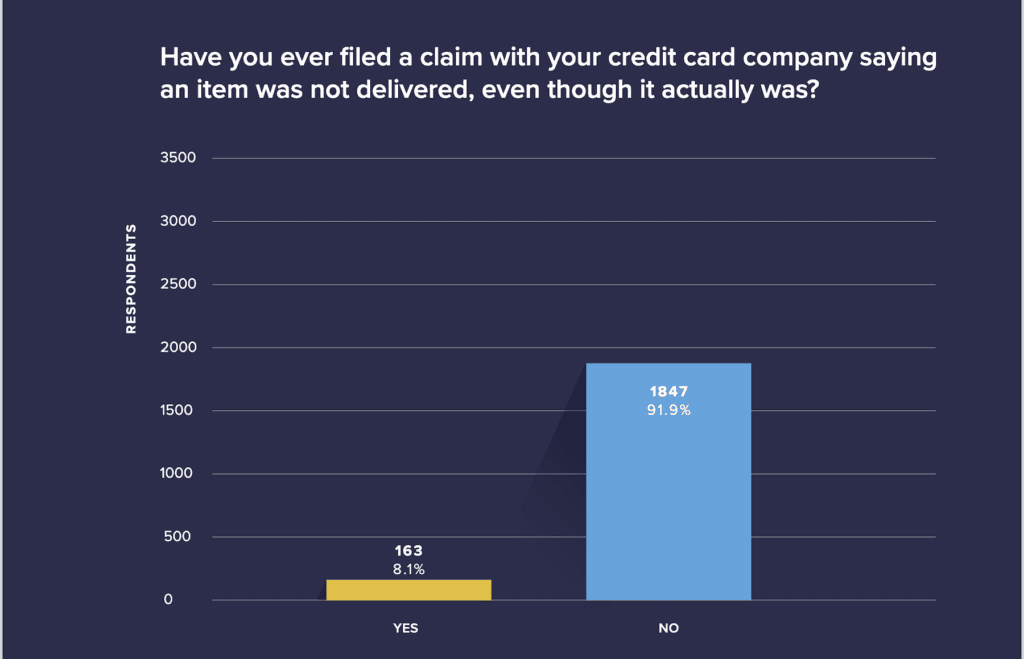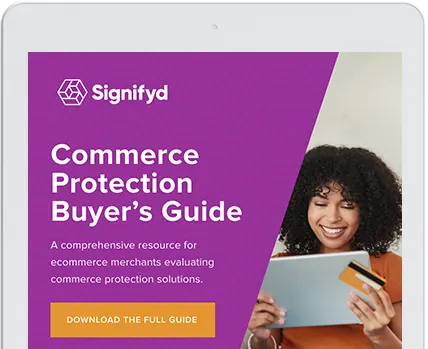Article updated: May 23, 2024
The primary goal for risk analysts is to detect and prevent fraudulent online transactions from being fulfilled while ensuring that the maximum number of legitimate orders are successfully filled.
To do that, an analyst needs to determine whether the order was placed by the authorized cardholder or a fraudster who’s using the legitimate cardholder’s information.
Seems straightforward, right?
The vast majority of orders that a risk analyst reviews fall into one or the other category. However, for a small subsection, the authorized cardholder and the likely fraudster are one and the same. This is known as friendly fraud, and it’s extremely difficult to detect in the card-not-present world. (And, according to Lexis Nexis, it’s a pain point for over a fifth of ecommerce merchants.)
Not only that, but friendly fraud is on the rise and growing rapidly, even faster in some categories than traditional payments fraud.

In 2023 friendly fraud grew faster than payments fraud in several categories — Signifyd data
Moreover, taking all the verticals together, friendly fraud far outstripped payments fraud in 2023, with friendly fraud rising 33% and payments fraud increasing by only 16%, according to Signifyd data.
Now that we’ve offered a friendly fraud definition, we’ll dive into what it is about our current environment that allows for friendly fraud to exist and continue to grow. Then, we’ll recommend some strategies for merchants to be proactive about mitigating cases of friendly fraud.
What is friendly fraud?
Friendly fraud is not a monolith, It manifests in various forms, each with its unique challenges. At its core, friendly fraud involves chargebacks initiated by the legitimate cardholder, but the motivations and circumstances can vary significantly. Friendly fraud can take many forms, including:
- Accidental chargebacks: Sometimes, friendly fraud is unintentional. A cardholder might not recognize a charge on their statement due to forgetfulness or because they don’t recognize the merchant’s billing descriptor. These cases often arise from simple misunderstandings rather than malicious intent.
- Customer experience fails: Sometimes a customer files a chargeback because something in the buying or customer support process disappointed them. Maybe the delivery was late. Maybe the product was defective or didn’t live up to the billing on the merchant’s digital site. Such failures can prompt a customer who had no original intention to file a chargeback to go ahead and take matters into their own hands.
- Deliberate abuse: In more concerning scenarios, consumers knowingly abuse the chargeback process. This form of friendly fraud is premeditated, with the cardholder intentionally seeking to exploit the system for financial gain.
- Family fraud: Another common scenario involves family members or acquaintances making unauthorized purchases that the primary cardholder later disputes, unaware of the transaction’s origin. Real-world examples could include a case where a customer forgot about a subscription renewal and filed a chargeback, or an instance where a teenager made purchases without parental consent, leading to a dispute.
What are the root causes of friendly fraud?
Understanding the psychology behind friendly fraud is crucial for effective prevention. Several factors can contribute to its prevalence:
- Consumer attitudes: The ease of online shopping and the perceived anonymity of digital transactions can sometimes embolden consumers to dispute charges they would otherwise accept in a physical store setting.
- Ease of filing chargebacks: The streamlined process for filing chargebacks, while consumer-friendly, can inadvertently encourage misuse, especially when consumers are unaware of the consequences for merchants.
- Lack of awareness: Many consumers don’t fully understand the impact of chargebacks on businesses, leading to a casual attitude towards disputing charges. In fact, 12.9% of consumers in a Signifyd survey said they committed chargeback abuse because “the company purchased from is very successful and wouldn’t miss it.”
Also, in more general terms, consumers have become much more comfortable taking advantage of merchants when they can. In a 2020 Signifyd survey, 14% of respondents admitted to being dishonest in order to keep a product and get a refund — 8% said a delivered order never arrived and 6% said a satisfactory product was not satisfactory.

In 2020, 8% of consumers said they lied about a package not being delivered.
That comfort with dishonesty has only grown as the line between dispute vs. fraud has become ever blurrier. In a 2022 Signifyd survey, 21% of consumers said they had requested a refund after saying a delivered package never arrived and 22% said they’d done the same, claiming a satisfactory product was unsatisfactory.

By 2022, more than 20% of consumers sought refunds by falsely claiming they never got their packages.
Three categories of chargebacks: Actual fraud, merchant error and friendly fraud
Because friendly fraud involves an authorized cardholder relying on getting around payment chargeback automation to file a different kind of chargeback — one on a seemingly legitimate transaction — it’s important to take a step back and review the three types of chargeback disputes a merchant faces.
All chargebacks fall into three main categories:
- Actual fraud. The most obvious reason for a chargeback is also the most common. A fraudster used a legitimate cardholder’s information, purchased an item from a merchant and the merchant shipped the order to the fraudster. Upon reviewing their statement, the authorized cardholder identifies a charge as illegitimate due to fraud and files a chargeback, requesting a refund.
- Customer experience fails: Sometimes a customer files a chargeback because something in the buying or customer support process disappointed them. Maybe the delivery was late. Maybe the product was defective or didn’t live up to the billing on the merchant’s digital site. Such failures can prompt a customer who had no original intention to file a chargeback to go ahead and take matters into their own hands.
- Friendly fraud. Friendly fraud (also called chargeback fraud or first-party fraud) is an industry term for authorized cardholders who dispute seemingly legitimate charges to their credit cards. The authorized cardholder may file a chargeback on a legitimate charge for a few reasons: (1) they want to avoid paying for the order in question, (2) they may have forgotten they made the purchase, or (3) there may be another household member who made the purchase in their name, and they don’t recognize the transaction.
Banks and card associations: Creating the environment for friendly fraud
The possibility that a legitimate cardholder can purchase an item from a merchant, and then attempt to avoid paying for it, strikes merchants as criminal. So, why do banks and card associations tolerate this behavior?
Let’s look at the environment that helps foster this activity.
Some quick background: Card associations (e.g. Visa or Mastercard) dictate participation guidelines to the banks that wish to issue their cards. (We discuss the payment ecosystem in more detail here.) For example, if a bank wants to issue or receive payment from Visa cards, they need to adhere to Visa’s interchange rules and regulations. Visa, Mastercard, and other card associations have a consumer first policy, as their primary goal is to increase the number of their cards used by the general population, and federal regulations dictate that consumers are guaranteed certain rights in regards to disputing transactions. This bears repeating: in order to increase cards in circulation, and avoid attracting federal inquiry, card associations prioritize consumer rights over merchant rights.
This means that banks, bound by card association rules and regulations, adopt a consumer first policy by association, and default to backing the consumer in a chargeback dispute against the merchant. Essentially, card associations force the hand of banks to favor the consumer over the merchant. Banks have little choice but to comply with the card association rules in chargeback disputes, unless the merchant can conclusively show that the cardholder acted fraudulently or with ill will.
But, as any merchant who has participated in a chargeback dispute can attest, attempting to win a chargeback is an uphill battle that rarely ends in victory for the merchant.
Visa’s CE 3.0 is one response to the rise of friendly fraud
This is where Visa’s new CE 3.0 comes in. The phrase is shorthand for compelling evidence 3.0, relatively new rules that spell out exactly what paperwork, or evidence, a merchant needs to provide in order to successfully dispute a chargeback.
The rules create a higher standard of proof but provide clear outcomes and a liability shift. Rather than producing one benchmark transaction to demonstrate a legitimate cardholder was behind an order, merchants must produce two that are at least 120 days old, but no more than a year old.
If a merchant successfully produces the required orders with the required data elements and conditions, liability for the chargeback will shift to the issuer.
The 3.0 change is new enough that merchants are still assessing its effectiveness. And different merchants in different verticals are experiencing different degrees of improvement in chargeback win rates.
Winning a chargeback can still be an uphill battle. When a consumer files a dispute with their issuing bank over a legitimate transaction in a case of friendly fraud, even merchants who believe they have the supporting documentation that shows the cardholder acting with ill will, the merchant may still potentially lose a legitimate sale.
How do you prove friendly fraud?
The reality for merchants is that friendly fraud is extremely difficult to detect. As mentioned earlier, when reviewing an order for fraud, fraud analysts are looking to detect if the card is being misused in any way by someone other than the authorized cardholder. When a card is being used by the cardholder themselves, it will be challenging to determine — based on that one transaction alone — whether that card is being used in a legitimate or malicious way, given that the purchase is indeed being conducted by the authorized cardholder.
That being said, a fraud analyst can look for anomalies in the order that might suggest that there is a risk of friendly fraud occurring, which would result in a friendly fraud chargeback.
When reviewing an order for a risk of friendly fraud, think about the following:
- Is the order amount larger than normal, either for this customer or for average customers on your site?
- Has the customer been placing a high frequency of orders?
- Is the item that the customer purchased commonly stolen?
- Does this customer have a track record of filing chargebacks, including friendly fraud chargebacks?
If the answer to any of these is yes, then we recommend following the steps below to both verify the order and minimize the risk of accepting an order that may be friendly fraud.
Even when a fraud analyst believes that they’re seeing a legitimate purchase made by the authorized cardholder, a merchant can protect themselves against fraud claims from their customers by documenting the transaction in the following ways:
- Make a validating phone call and record it — with the customer’s knowledge. For example, if a merchant’s average transaction amount is $275, and a customer places an order for $6,300, that should warrant extra investigation by the fraud analyst, and likely a phone call or email outreach to the customer. When a merchant makes a validating phone call, they can record their conversations to use as evidence later for the banks should a chargeback be filed.
- Always gather and save delivery documentation. Merchants can request that a package must be signed for to be delivered, proving that it is now in the hands of the purchaser or listed recipient of the order. Most of the time a merchant can request that UPS or FedEx request signatures on all their orders to prevent claims that the package was stolen off the porch or never delivered. The merchant can use the signature as evidence to the banks that the customer has possession of the merchandise.
- Make a commitment to providing excellent customer service. By building a relationship with your customers, they are far less likely to commit friendly fraud against you. If there is any issue at all with the product or the service and they know that you are willing to help them, the customer is more likely to ask for help first before filing a chargeback.
By documenting shipping, recording phone calls, keeping track of all email conversations and above all, providing excellent customer service to customers, merchants can significantly reduce the number of chargebacks that they receive.
Of course, merchants must always be mindful that extra steps — such as calling customers for verification and requiring signatures — add friction to a purchase. The secret is to be vigilant, but not paranoid as friction leads to lost conversions.
Leveraging advanced technologies for fraud prevention
In the fight against friendly fraud, technology is a key ally. Signifyd leverages cutting-edge tools to identify and prevent fraudulent activities and to differentiate between dispute vs. fraud in order to provide chargeback fraud protection. Signifyd relies on:
- AI and machine learning: These technologies enable the analysis of vast amounts of transaction data to identify patterns indicative of friendly fraud and patterns likely to result in other fraud chargebacks..
- Behavioral analytics: By examining customer behavior, merchants can detect anomalies that may signal friendly fraud, such as unusual purchasing patterns or a history of chargebacks, including friendly fraud chargebacks..
- Transaction monitoring: Continuous monitoring of transactions helps in real-time detection of potential fraud, allowing for immediate action to prevent losses.
Integrating Signifyd’s solutions for enhanced protection
Incorporating Signifyd’s fraud protection and abuse prevention solutions can significantly bolster a merchant’s defenses against friendly fraud and provide chargeback fraud protection. These solutions offer real-time decision-making capabilities, reducing the incidence of fraudulent chargebacks and providing a financial guarantee against fraud losses.
How to prevent friendly fraud and with customer deny lists and the network effect
Similar to our documentation advice above, if a merchant has lost a dispute from a customer on what they believe is a clear case of friendly fraud, they should document the chargeback in order to avoid accepting an order from that customer in the future. While it is indeed possible that this customer filed their first chargeback, and was unaware that they could initially reach out to the merchant to resolve the matter, it’s quite likely that they have filed chargebacks against other merchants, won and are continuing their pattern.
Keeping a customer deny list helps prevent you from repeat friendly fraud offenses, but it is likely to be of little use in detecting new attempts. It also risks permanently turning away good customers who are not, in fact, serial fraud and chargeback producers.
Consider though: If a merchant uses a fraud detection and prevention tool, they may benefit from a network effect. For example, Signifyd merchant customers benefit from data that Signifyd has across all of its merchants on customers who have committed friendly fraud. Thus, if a customer who committed fraud with one Signifyd merchant attempts to buy from another Signifyd merchant, Signifyd can identify that order and block the transaction.
Signifyd also offers automated friendly fraud management with its Abuse Prevention solution. Abuse prevention extends Signifyd’s ecommerce chargeback protection, including item not received and significantly not as described claims, and comes with a financial guarantee.
Success stories in combating friendly fraud
Signifyd’s clients have seen notable successes in mitigating friendly fraud. For instance, a major electronics retailer implemented Signifyd’s solutions and saw a significant reduction in chargeback rates. The retailer used a combination of AI-driven fraud detection and manual review processes to identify and prevent potential friendly fraud cases.
Best practices for merchants to mitigate friendly fraud
To combat friendly fraud, merchants can adopt several best practices:
- Clear communication: Ensure that billing descriptors are clear and recognizable to customers.
- Detailed record-keeping: Maintain comprehensive records of transactions, including customer communications and delivery confirmations. Be prepared to meet Visa’s compelling evidence 3.0 standards.
- Utilize fraud prevention tools: Implement advanced tools like those offered by Signifyd for real-time fraud detection and prevention.
Conclusion: The responsibility is on the merchant
Being proactive about providing excellent customer service and documenting transactions are a merchant’s best weapons against friendly fraud. While this won’t eradicate every occurrence, it can certainly reduce them. We also recommend examining your fraud prevention tool to see if you can benefit from a network effect and the added intelligence of insights into occurrences of friendly fraud across other merchants.
Embracing proactivity in the fight against friendly fraud
In the evolving landscape of ecommerce, the specter of friendly fraud looms large, posing significant challenges to merchants worldwide. However, it’s clear that a proactive approach, rather than a reactive one, is key to staying ahead in this ongoing battle. By understanding the nuances of friendly fraud, analyzing its root causes and implementing advanced detection and prevention strategies, merchants can significantly mitigate its impact.
Signifyd stands at the forefront of this fight, offering cutting-edge solutions that blend AI, machine learning and behavioral analytics to safeguard businesses. Their success stories are a testament to the effectiveness of these strategies.
The responsibility to adapt and evolve with these changing fraud trends falls squarely on merchants’ shoulders. But they are not alone.
By integrating comprehensive solutions like those offered by Signifyd and maintaining a relentless commitment to excellent customer service and detailed record-keeping, they can not only protect their businesses but also enhance the trust and loyalty of their customers. In the end, combating friendly fraud is not just about protecting transactions; it’s about fostering a safer, more trustworthy ecommerce environment for everyone.
We can help prevent friendly fraud chargebacks.











